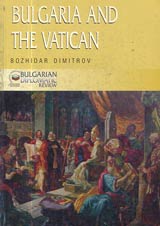- Американска и канадска художествена литература
- Антикварни книги
- Антични автори
- Балканска художествена литература
- Библиофилски издания
- Биология
- Българска художествена литература
- География, пътеводители
- Детска литература
- Европейска художествена литература
- Езикознание, лингвистика, семиотика, филология
- Езотерика, духовни учения
- Здравна и медицинска литература
- Земеделие и животновъдство
- Изкуство
- Икономическа литература
- История
- Календари, сувенири
- Компютърна литература
- Кулинарна литература
- Културология, етнология и фолклор
- Латиноамериканска художествена литература
- Литературна критика
- Литературна периодика
- Медии и комуникации
- Нобелова награда за литература
- Политология
- Правна литература
- Православна литература
- Психология
- Речници, справочници, енциклопедии
- Социология
- Спорт, хоби
- Точни науки, техника
- Учебна литература, Педагогика
- Философия
- Художествена литература от Азия, Африка и Австралия

Bulgaria and the Vatican
Продуктов номер: 8527Изчерпана
Автор: Божидар Димитров
Категория: Българска история на чужди езици | Българско Средновековие
Издателство: Български дипломатически преглед
Състояние: Нова книга
56 страници
меки корици
Първо издание: 2002
Народност: българска
Foreword Cdtholicism in Bulgaria Catholics and Uniats (Orthodox Bulgarians that have recognised the Holy Pope as Head of their Church) are about 80 up to 100 thousand in Bulgaria today. How did that religious denomination appear in the Bulgarian Orthodox multitude of about 9 million people? In 1154, when the Western Churches split, there was not a single Catholic in the Bulgarian lands. In 1204, as a result of an agreement between Tsar Caloyan and Pope Innocent III, all Bulgarians became Uniats. However, in 1235, the Orthodox Christians in our country once again restored the Bulgarian Patriarchate, i.e. an independent Bulgarian Orthodox Church. In 1366 Hungary conquered the principality of Vidin on the Danube, where the Hungarian monks with the assistance of their troops converted to Catholicism about 200 thousand of the local population. Ivan Alexander, the then Bulgarian Tsar, retaliated with a "Blietzkrieg" and in 1369 defeated the Hungarian occupation forces, restoring his son as Prince of Vidin, whereafter the 200 000 people forcefully converted to Catholicism were reconverted back to the Orthodox Church, while the Hungarian monks were captured and drowned in the Danube. The Ottoman Turks invaded these lands around the year 1396 and found an entirely Orthodox population, which was quickly conquered. The history of present-day Catholicism in Bulgaria began in 1596, when i mendicant Franciscan monk discovered that at the town of Tchiprovtsy as veil as at three of the villages nearby (Copillovtsy, Zhelezna, and Clissoura) he predominant part of the population was made of Bulgarian Catholics. We laven't got now any records as of when and how these Bulgarians became Roman Catholics. In the past, some of our Historians voiced a hypothesis that these Catholics were the offspring of some German overlanders, or of Albanian emigrants. Recently discovered Turkish archives point out, however, that the Tchiprovtsy Catholics were not foreigners but Bulgarians, some of them of the Nobility and Royal retinue, that had accompanied Prince Frougin, the son of Tsar Ivan Shishman, in his exile to Hungary. It was there that they embraced Catholicism but then, come 1440, they returned back home after an agreement with the Turkish authorities and settled down at the town of Tchiprovtsy and the area around it. The Vatican decided to use that small Bulgarian nest of Catholicism in order to work on for further, more solid positions within Bulgaria, which in the 1396-1878 period was under the rule of the Ottoman Empire. In a comparatively short period of time hundreds of these Bulgarian Roman Catholics were given training and education at the Catholic Lyceum at Tchiprovets, as well as at the Clementine and Illyrian colleges in Italy. They headed the Catholic structures within the Bulgarian territories, where in the 1601—1647 period, schools, churches, monasteries, and nunneries were growing up as fast as mushrooms in a summer afternoon. The Bulgarian Catholic Missionaries succeeded in converting to Catholicism tens of thousands of Bulgarians within the regions of Nicopol on the Danube and Plovdiv as well. Almost all of them had been adherents to a heretic sect known as Paulikians. Catholicism in fact rescued these people for the Bulgarian nations as they were all be under the immediate threat of being converted to Islam, thus becoming Turks by nationality as well. Many Bulgarians working in service of the numerous Doubrouvnic traders were also converted to Catholicism within that period of time. The chances of Catholicism of winning a considerable part of the Bulgarians in those times were very good indeed, as the higher princes of the Orthodox clergy were predominantly Greek nationals, who led a denationalisation and Hellenisation policy, and they burdened their Orthodox flocks with enormous church taxes, tithes, etc. The Catholic priests were mostly Bulgarians, they collected no taxes or tithes, and were fervent Bulgarian patriots. Yet, they acted rashly in organising an uprising of the Bulgarian Roman Catholics against the Ottoman Turks in 1688. All the Bulgarian Catholic villages and towns were demolished to the ground, part of their population executed, others - enslaved and exiled. Some of the insurgents managed to escape, having crossed the Danube and gone North where, after many trials, they managed to settle down in the region of Banat.